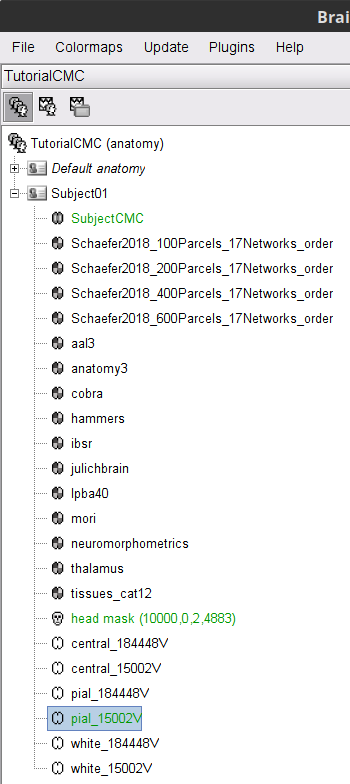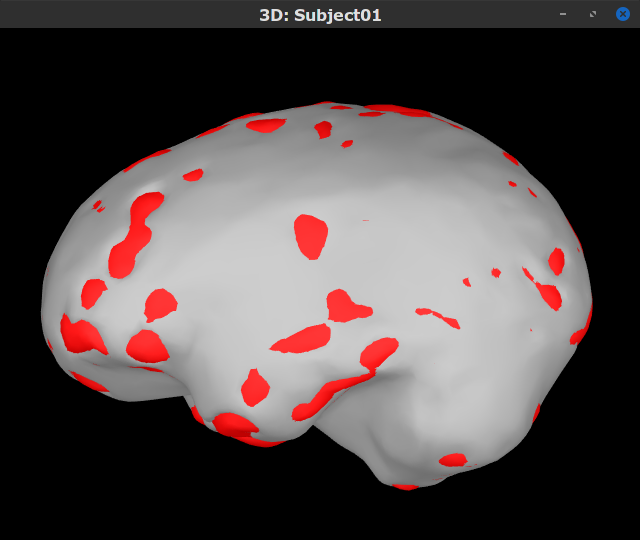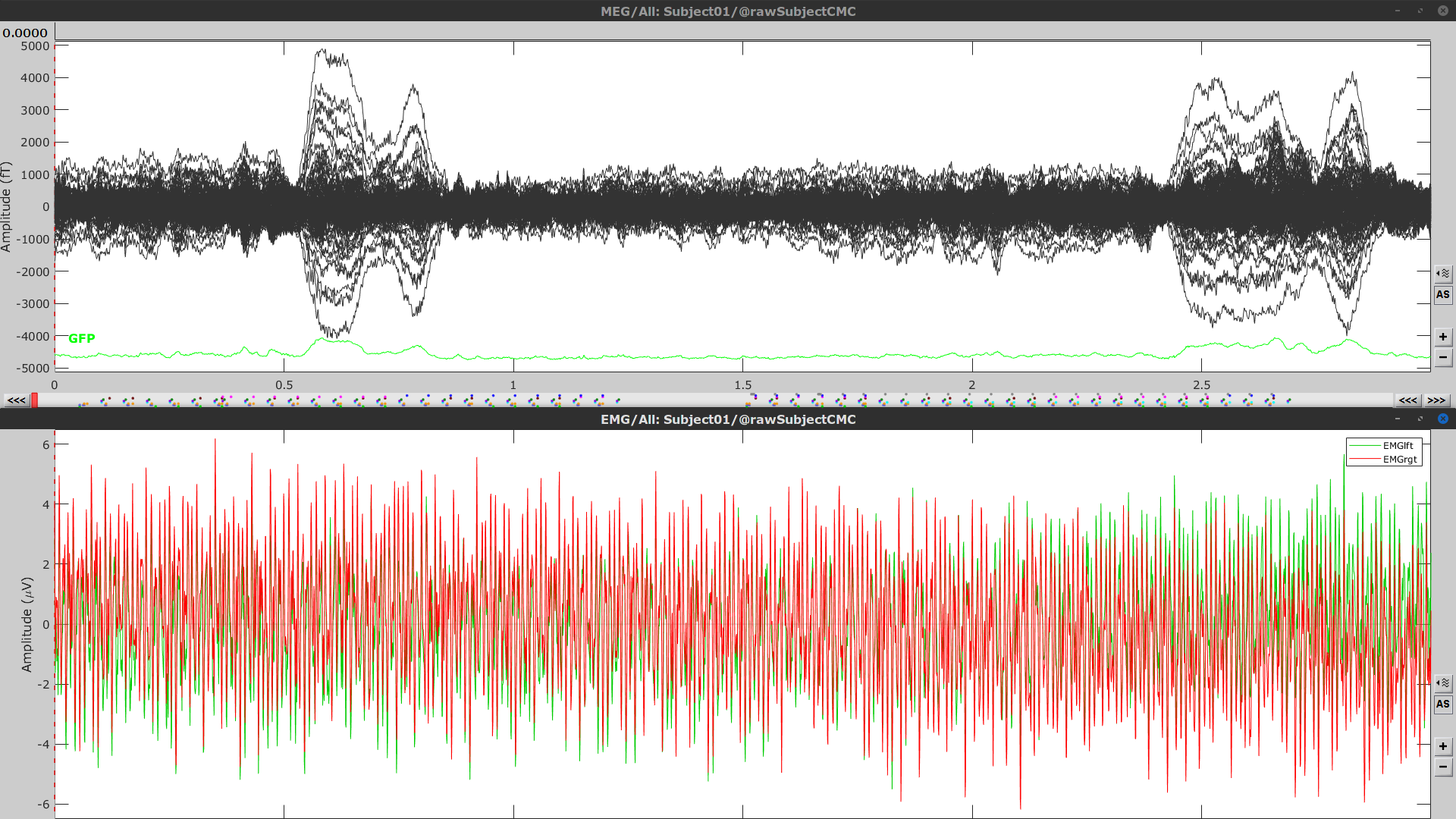|
Size: 24025
Comment:
|
Size: 14731
Comment:
|
| Deletions are marked like this. | Additions are marked like this. |
| Line 1: | Line 1: |
| <<HTML(<style>.backtick {font-size: 16px;}</style>)>><<HTML(<style>abbr {font-weight: bold;}</style>)>> <<HTML(<style>em strong {font-weight: normal; font-style: normal; padding: 2px; border-radius: 5px; background-color: #EEE; color: #111;}</style>)>> | <<HTML(<style>.backtick {font-size: 16px;}</style>)>><<HTML(<style>abbr {font-weight: bold;}</style>)>> <<HTML(<style>em strong {font-weight: bold; font-style: normal; padding: 2px; border-radius: 5px; background-color: #DDD; color: #111;}</style>)>> |
| Line 4: | Line 4: |
| '''[TUTORIAL UNDER DEVELOPMENT: NOT READY FOR PUBLIC USE] ''' |
|
| Line 16: | Line 18: |
| The dataset is comprised of MEG (151-channel CTF MEG system) and bipolar EMG (from left and right extensor carpi radialis longus muscles) recordings from one subject during an experiment in which the subject had to lift her hand and exert a constant force against a lever. The force was monitored by strain gauges on the lever. The subject performed two blocks of 25 trials in which either the left or the right wrist was extended for about 10 seconds. Only data for the left wrist will be analyzed in this tutorial. | The dataset is comprised of MEG (151-channel CTF MEG system) and bipolar EMG (from left and right extensor carpi radialis longus muscles) recordings from one subject during an experiment in which the subject had to lift her hand and exert a constant force against a lever. The force was monitored by strain gauges on the lever. The subject performed two blocks of 25 trials in which either the left or the right wrist was extended for about 10 seconds. In addition to the MEG and EMG signals, EOG signal was recorded to assist the removal of ocular artifacts. Only data for the left wrist will be analyzed in this tutorial. |
| Line 39: | Line 41: |
| IMAGE after_mni_norm | {{{#!wiki comment {{attachment:viewer_mni_norm.png}} }}} . [[https://neuroimage.usc.edu/brainstorm/Tutorials/CorticomuscularCoherence?action=AttachFile&do=get&target=viewer_mni_norm.png|{{attachment:viewer_mni_norm.png|https://neuroimage.usc.edu/brainstorm/Tutorials/CorticomuscularCoherence?action=AttachFile&do=get&target=viewer_mni_norm.png}}]] |
| Line 53: | Line 58: |
| IMAGE result_tree | . {{attachment:import_result.png||width="40%"}} |
| Line 57: | Line 62: |
| IMAGE overlap cortex and innerskul | . {{attachment:over_innerskul_cortex.png||width="50%"}} |
| Line 60: | Line 65: |
| === Link the recordings === | |
| Line 67: | Line 73: |
| * The '''''Link to raw file''''' node is a '''link to the original file''' that you imported. All the relevant meta-data was read from the MEG dataset and copied inside the link itself (sampling rate, number of samples, event markers and other details about the acquisition session). As it is a link, no MEG recordings were copied to the database. When we open this file, the values are read directly from the original files in the .ds folder. [[Tutorials/ChannelFile#Review_vs_Import|More information]]. | * The '''''Link to raw file''''' node is a '''link to the original file''' that was selected. All the relevant meta-data was read from the MEG dataset and copied inside the link itself (sampling rate, number of samples, event markers and other details about the acquisition session). As it is a link, no MEG recordings were copied to the database. When we open this file, the values are read directly from the original files in the .ds folder. [[Tutorials/ChannelFile#Review_vs_Import|More information]]. |
| Line 69: | Line 75: |
| IMAGE functional result_tree | . {{attachment:review_raw.png}} <<BR>> |
| Line 71: | Line 77: |
| === Display MEG helmet and sensors === | |
| Line 73: | Line 80: |
| IMAGE helmet and sensors | . {{attachment:helmet_sensors.png}} |
| Line 76: | Line 83: |
| * Right-click on the '''''Link to raw file''''' node, then '''''Switch epoched/continuous''''' to convert the file to '''continuous'''. * Right-click on the '''''Link to raw file''''' node, then '''''MEG > Display time series''''' (or double-click on the node). This will open a new time series figure and enable the '''Time panel''' and the '''Record''' tab in the main Brainstorm window. Controls in these two panels are used to [[Tutorials/ReviewRaw|explore the time series]]. * In addition we can display the EMG signals, right-click on the '''''Link to raw file''''' node, then '''''EMG > Display time series'''''. |
* Right-click on the '''''Link to raw file''''' node, then '''''Switch epoched/continuous''''' to convert the file to '''continuous'''. * Right-click on the '''''Link to raw file''''' node, then '''''MEG > Display time series''''' (or double-click on the node). This will open a new time series figure and enable the '''Time panel''' and the '''Record''' tab in the main Brainstorm window. Controls in these two panels are used to [[Tutorials/ReviewRaw|explore the time series]]. * In addition we can display the EMG signals, right-click on the '''''Link to raw file''''' node, then '''''EMG > Display time series'''''. |
| Line 80: | Line 87: |
| IMAGE both MEG up, MEG down | . [[https://neuroimage.usc.edu/brainstorm/Tutorials/CorticomuscularCoherence?action=AttachFile&do=get&target=timeseries_meg_emg.png|{{attachment:timeseries_meg_emg.png|https://neuroimage.usc.edu/brainstorm/Tutorials/CorticomuscularCoherence?action=AttachFile&do=get&target=timeseries_meg_emg.png}}]] |
| Line 82: | Line 89: |
| The colored dots on top of the recordings in the time series figures represent the [[Tutorials/EventMarkers|event markers]] (or triggers) saved in this dataset. In addition to these events, the start of the either left or right trials is saved in the auxiliary channel named '''Stim'''. To add these markers: | == Event markers == The colored dots on top of the recordings in the time series figures represent the [[Tutorials/EventMarkers|event markers]] (or triggers) saved in this dataset. In addition to these events, the start of the either left or right trials is saved in the auxiliary channel named '''Stim'''. To add these markers: |
| Line 85: | Line 93: |
| * New events will appear, from these, we are only interested in the events from '''U1''' to '''U25''' that correspond to the 25 left trials. * Delete all the other events: select the events to delete with '''Ctrl+click''', when done go the menu '''''Events > Delete group''''' and confirm. Alternatively, you can do '''Ctrl+A''' to select all the events and deselect the U1 to U25 events. |
|
| Line 89: | Line 94: |
| Read the information saved during the acquisition in a digital auxiliary channel (eg. a stimulus channel) and generate events. | . {{attachment:read_evnt_ch.png}} |
| Line 91: | Line 96: |
| Due to the nature of this experiment, we need to |
New events will appear, from these, we are only interested in the events from '''U1''' to '''U25''' that correspond to the 25 left trials. Thus we will remove the other events, and merge the left trial events. |
| Line 94: | Line 98: |
| * Delete all the other events: select the events to delete with '''Ctrl+click''', when done go the menu '''''Events > Delete group''''' and confirm. Alternatively, you can do '''Ctrl+A''' to select all the events and deselect the '''U1''' to '''U25''' events. * To be in line with the original FieldTrip tutorial, we will reject the trial 7. Select the events '''U1''' to '''U6''' and '''U8''' to '''U25''' events, then go the menu '''''Events > Merge group''''' and enter the label '''Left'''. |
|
| Line 95: | Line 101: |
| * Change the default duration that is reviewed to '''10s'''. <<BR>> {{attachment:review_avgref.gif||width="188"}} {{attachment:review_duration.gif||width="198"}} * In the figure, select the display option "'''Flip Y Axis'''" to have the negative values pointing up (convention used by many neurologists). <<BR>><<BR>> {{attachment:review_flip.gif}} * Open a '''2D Sensor cap''' map of the EEG sensor values: * Right-click on "Link to raw file" again > EEG > '''2D Sensor cap''' * In the Record tab, set the Montage to this view to "'''Average reference'''" * Open the '''ECG '''and '''EOG '''traces, to avoid confusing spikes with cardiac or ocular artifacts: * Right-click on the Link to raw file > ECG > Display time series * Right-click on the Link to raw file > EOG > Display time series * The ECG is almost mandatory. The EOG is optional: it can be helpful for beginners but an experienced reviewer will easily recognize the eye movements directly in the EEG data. * Re-arrange the figures in a convenient way, for example as illustrated below. Then disable the automatic positioning of the figures (layout menu at the top-right of the Brainstorm figure > None), so that your figure arrangement doesn't get lost when you open a new figure. * Having a lot of windows open may slow down significantly the display because each time you change the current time, all the figures have to be updated. A lot of space is also wasted on the screen due to window frames. The number of windows to open has to be balanced between the amount of information to display and the ease of use. <<BR>><<BR>> {{attachment:reviewall.gif||width="594"}} |
. {{attachment:left_24.png}} |
| Line 107: | Line 103: |
| === Frequency filters === Go to the Filter tab to enable some display frequency filters. General recommendations are: |
These events are located at the beginning of the 10 s trials of left wrist movement. In the following steps we will compute the coherence for 1 s epochs for the first 8 s of the trial, thus we need extra events. |
| Line 110: | Line 105: |
| * High-pass filter: '''0.5 Hz''' * Low-pass filter: '''80 Hz'''<<BR>><<BR>> {{attachment:filters.gif}} * Note that if you have filters selected in this panel, the display of the EEG signals will be '''slower'''. Each time you will go to the next page of recordings, the filters will be applied on the fly to the recordings. The computation time is not very long at each page, but can become annoying when reviewing a lot of data. For a faster display of filtered signals, you may consider '''apply the filters to the file''' (with the process Pre-process > Band-pass filter) and then review the recordings without visualization filters. |
* Duplicate 7 times the '''Left''' events by selecting '''''Duplicate group''''' in the '''''Events''''' menu. This will create the groups '''Left_02 to Left_08'''. * To each copy of the '''Left''' events, we will add a time off, 1 s for '''Left02''', 2 s for '''Left03''', and so on. Select the event group to add the offset, then go to the menu '''''Events > Delete group'''''. |
| Line 114: | Line 108: |
| === Time and amplitude resolution === The resolutions of the time and amplitude axes have a lot of importance for the visual detection of epileptic spikes. The shapes we are looking for are altered by the horizontal and vertical scaling. The distance unit on a screen is the pixel, we can set how much time is represented by one pixel horizontally and how much amplitude is represented by one pixel vertically. |
. {{attachment:dup_offset.png}} |
| Line 117: | Line 110: |
| In the Brainstorm interface, this resolution is usually set implicitly: you can set the size of the window, the duration or recordings reviewed at once (text box "duration" in tab Record) and the maximum amplitude to show in the figure (buttons [...] and [AS] on the right of the time series figure). From there, you can also zoom in time ([<], [>], mouse wheel) or amplitude (['''^'''], [v], Shift+mouse wheel). These parameters are convenient to explore the recordings interactively but don't allow us to have reproducible displays with constant time and amplitude resolutions. | * Finally merge all the '''Left''' events into '''Left''', and select '''''Save modifications''''' in the '''''File''''' menu in the '''Record tab'''. |
| Line 119: | Line 112: |
| To set the figure resolution explicitly: right-click on the figure > '''Figure > Set axes resolution'''. Note that this interface does not store the input values, it just modifies the other parameters (figure size, time window, max amplitude) to fit the resolution objectives. If you modify these parameters (resize the figure, keep the button [AS] selected and scroll in time, etc) the resolution is lost, you have to set it again manually. In particular, make sure you '''disable the auto-scaling''' ([AS] button in the time series figure) if you want to preserve the aspect ratio while you scroll through the data. | . {{attachment:left_192.png}} |
| Line 121: | Line 114: |
| This operation typically has to be repeated everytime you open a new file. For a faster access to this option, use the keyboard shortcut '''Ctrl+O'''. The option window offers by default the last values that you entered, just press '''Enter '''to apply them again. | == Pre-process MEG recordings == Three of the typical pre-processing steps for MEG recordings consist in: |
| Line 123: | Line 117: |
| Recommendations for this dataset are: | 1. [[Tutorials/ArtifactsFilter|removing the power line artifacts]], 50 Hz for this recording |
| Line 125: | Line 119: |
| * Time axis: '''170 pixels/sec''' (~55 mm/sec) * Amplitude: '''15 μV/pixels''' (~45 μV/mm)<<BR>><<BR>> {{attachment:resolution.gif}} |
1. [[Tutorials/ArtifactsDetect|detection]] and [[Tutorials/ArtifactsSsp|removal of artifacts with SSP]] |
| Line 128: | Line 121: |
| === User setups === This preparation of the reviewing environment requires a large number of operations, and would become quickly annoying if you have to repeat it every time you open a file. You can use the menu "User setups" to save a window configuration and reload it in one click later. In the menu "Window layout", at the top-right of the Brainstorm window, select User setup > New setup. Enter a name of your choice for this particular window arrangement. |
1. [[Tutorials/BadSegments|detection of segments with other artifacts]]. |
| Line 131: | Line 123: |
| This operation will also disable the automatic window arrangement (Window layout > None). To reload it later, open one figure on the dataset you want to review and then select your new entry in the User setup menu. | First, to avoid an excessive requirement of memory during the pre-processing, we need to create an '''intermediate file''' for the '''Link to raw file'''. This intermediate file will contain the same data as the original `.ds` file, but with the CTF compensation projector applied to the recordings values (instead of being just saved as linear operators on the side). |
| Line 133: | Line 125: |
| . {{attachment:usersetup.gif||width="347"}} | * In the Process1 box: Drag and drop the "Link to raw file". * Run process '''Artifacts > Apply SSP and CTF compensation''' |
| Line 135: | Line 128: |
| === Multiple montages === It may be interesting for some cases to display different groups of sensors in multiple windows (eg. with an MEG system with 300 sensors), or some complicated epilepsy cases where you would like to review at the same time multiple montages (eg. longitudinal and transversal bipolar montages). |
The intermediate file is located in named '''''Raw | clean ''''' and is located in the the '''''SubjectCMC_clean''''' study. |
| Line 138: | Line 130: |
| * Open your full reviewing environment as described before, where the EEG signals are displayed with the "'''Average reference'''" montage. * Open another view on the same data with the "'''Longitudinal 3'''" montage ("double-banana" LB-18.3) * Right-click on the "Link to raw file" again > EEG > Display time series * Alternatively, you can right-click on the existing figure > Figure > Clone figure. * Then set the montage for this new figure to "Longitudinal 3". * Resize all the figures to make room for the new window. * Save this window configuration as a new "User setup". * If you don't see the "Longitudinal 3" menu, it is probably because you have been using Brainstorm before these predefined montages were made available in the distribution. To add them manually: * In the Record tab, select "Edit montages" in the drop-down menu * Click on the "Load montage" button. * Go to the folder "brainstorm3/toolbox/sensors/private/", and select the first file. * Note that a new entry (probably "Longitudinal 1") is added to the list of available montages. * Repeat the operation with all the files in the folder "brainstorm3/toolbox/sensors/private/". * Click on "Save" to close the montage editor and now select "Longitudinal 3". {{attachment:reviewall2.gif||width="678"}} * More information available in the tutorial [[Tutorials/MontageEditor|Montage editor]]. |
FIGURE Process, and Tree |
| Line 155: | Line 132: |
| === Scalp current density === In the example below, see how the montage '''Scalp current density''' can enhance the visual detection of spikes. [[https://neuroimage.usc.edu/brainstorm/Tutorials/MontageEditor#Scalp_current_density|More information]]. |
=== Power line artifacts === Let's start with locating the spectral components and impact of the power line noise. |
| Line 158: | Line 135: |
| . {{attachment:scd_off.gif||width="601",height="189"}} <<BR>><<BR>> {{attachment:scd_on.gif||width="601",height="189"}} | * In the Process1 box: Drag and drop the "Link to raw file". * Run process '''''Frequency > Power spectrum density (Welch)'''''<<BR>> * '''All file''', '''Window length='''60 s and '''Overlap'''=50%.<<BR>> |
| Line 160: | Line 139: |
| == Mark spikes == === Detect heartbeats === When you have a clean ECG signal for your patient, you can automatically identify all the heartbeats in the recordings. Because heartbeats can cause sharp waves in some EEG traces, it helps the reviewing process to have all the cardiac events marked in the recordings. |
* Double-click on the new PSD file to display it.<<BR>> |
| Line 164: | Line 141: |
| * Right-click on the "Link to raw file" > EEG > '''Display time series''' (or simply double-click on it). * In the tab Record, menu Artifacts > Detect heartbeats: Channel='''ECG''', All file. <<BR>><<BR>> {{attachment:detect_ecg.gif||width="470",height="200"}} |
* The PSD shows relevant peaks at 50Hz, 150Hz and 250Hz. We will use notch filters to remove those frequency components from the MEG signals. Run the process '''''Pre-processing > Notch filter''''' with '''Frequencies to remove (Hz)''' = 50.00, 150.00, 250.00 |
| Line 167: | Line 143: |
| === Import the spike markers === Some spikes were marked by the epileptologists at the Epilepsy Center in Freiburg and saved in an external text file. We are going to import this file manually. * In the tab Record, menu File > '''Add events from files'''... * Select format '''Array of times''' (text file containing the timing of the markers) * Select file '''sample_epilepsy/data/''''''tutorial_spikes.txt''' * When prompted, enter the event name "'''SPIKE'''" * A new category SPIKE is visible in the events list, containing 58 markers. Click on a few of them and try to identify the shape of the spike (mostly visible on the channel FC1). Then close the viewer and save the modifications. <<BR>><<BR>> {{attachment:events_import.gif}} * The two other types of events that were present initially in the file (REM/REM_Ende) indicated the beginning and the end of periods or REM sleep (the patient is sleeping during the entire session). === Manual marking === If you are marking the events by yourself, you could follow this procedure: * Close all the current figures ("Close all" button at the top-right corner of the Brainstorm window). * Double-click on the "Link to raw file" to open a continuous file viewer, and load your reviewing environment (menu User setups). * Start by creating a group of events (Events > Add group), and select it in the list of events. * Make sure that the time and amplitude resolutions are what you are used to<<BR>>(right-click on the figure > Figure > Set axes resolution) * Scroll through the recordings using the [<<<] and [>>>] buttons or shortcuts such as F3 or F4 (complete list and descriptions available when you hover your mouse over these buttons). * You can adjust the gain of the electrodes to observe better an event with the buttons ['''^'''] and [v], with the keyboard (+/-) or the mouse ([Shift+mouse wheel] or [Right-click+move up/down]). * When you identify a spike, click in a white area of the figure in order to place the time cursor at the peak of the spike. If you click on the signal itself, it selects the corresponding channel, but you can use the shortcut Shift+Click to prevent this behavior and force the time cursor to be moved instead. * Press Ctrl+E to add a marker where the time cursor is. * If you are marking multiple types of events, it is convenient to set up some additional keyboard shortcuts. Using the menu '''Events > Edit keyboard shortcuts''', you can associate custom events to the keys 1 to 9 of the keyboard. Define the name of the event type to create for each key, and then simply press the corresponding key to add/delete a marker at the current time position. * To jump to the next/previous event in the current category: use the keyboard shortcuts [Shift+arrow right] and [Shift+arrow left] * More information on the data viewer, see tutorial: [[Tutorials/ReviewRaw|Review continuous recordings]]. == Pre-process recordings == Two of the typical pre-processing steps consist in removing the power lines artifacts (50 Hz or 60Hz) and the frequencies we are not interested in (a low-pass filter to remove the high-frequency noise and a high-pass filter to remove the very slow components of the signals). Let's start with a spectral evaluation of this file. === Power spectrum === * In the Process1 box: Drag and drop the "Link to raw file". * Run process '''Frequency > Power spectrum density (Welch)''': All file, Length='''10s''', Overlap=50%.<<BR>> {{attachment:psd1.gif||width="510",height="305"}} * Double-click on the new PSD file to display it.<<BR>> {{attachment:psd2.gif||width="557",height="199"}} * This frequency spectrum does not show any particular peak at 50/60Hz, there is no notch filter to apply on these recordings. If we had to, we would run the process "Pre-processing > Notch filter" as explained in the tutorial [[Tutorials/ArtifactsFilter|Detect and remove artifacts]]. === Band-pass filter === The filters we selected for reviewing the recordings were for visualization only, they were not applied to the file. In order to apply these filters permanently to the recordings, we need to do the following: * Keep the "Link to raw file" selected in the Process1 list. * Run process '''Pre-process > Band-pass filter''': '''[0.5,80]Hz''', 60dB, no mirror, sensors='''EEG'''<<BR>><<BR>> {{attachment:bandpass.gif}} * Note that this new continuous file is saved in your Brainstorm database, while the original file is saved in a separate folder (sample_epilepsy). If you delete the link to the original file with the database explorer, it would not delete the actual file. If you delete the link to the filtered file, it would delete the file itself. == Handle events == Fusion all the left events == Pre-process recordings == Removing artifacts |
* Compute the PSD for the filtered MEG signals to verify effect of the notch the filters. |
| Line 232: | Line 158: |
| * Kilner JM, Baker SN, Salenius S, Hari R, Lemon RN. <<BR>> [[https://doi.org/10.1523/JNEUROSCI.20-23-08838.2000|Human Cortical Muscle Coherence Is Directly Related to Specific Motor Parameters]]. <<BR>> J Neurosci. 2000 Dec 1;20(23):8838–45. | * Kilner JM, Baker SN, Salenius S, Hari R, Lemon RN. <<BR>> [[https://doi.org/10.1523/JNEUROSCI.20-23-08838.2000|Human Cortical Muscle Coherence Is Directly Related to Specific Motor Parameters]]. <<BR>> J Neurosci. 2000 Dec 1;20(23):8838–45. '' '' |
| Line 234: | Line 160: |
| * Liu J, Sheng Y, Liu H. <<BR>> [[https://doi.org/10.3389/fnhum.2019.00100Corticomuscular%20Coherence%20and%20Its%20Applications:%20A%20Review|https://doi.org/10.3389/fnhum.2019.00100Corticomuscular%20Coherence%20and%20Its%20Applications:%20A%20Review]]. Front Hum Neurosci. 2019 Mar 20;13:100. | * ''Liu J, Sheng Y, Liu H. <<BR>> [[https://doi.org/10.3389/fnhum.2019.00100Corticomuscular%20Coherence%20and%20Its%20Applications:%20A%20Review|https://doi.org/10.3389/fnhum.2019.00100Corticomuscular%20Coherence%20and%20Its%20Applications:%20A%20Review]]. Front Hum Neurosci. 2019 Mar 20;13:100. '' |
| Line 236: | Line 162: |
| {{{#!wiki comment * Schoffelen J-M, Poort J, Oostenveld R, Fries P. <<BR>> [[https://doi.org/10.1523/JNEUROSCI.4882-10.2011|Selective Movement Preparation Is Subserved by Selective Increases in Corticomuscular Gamma-Band Coherence]]. Journal of Neuroscience. 2011 May 4;31(18):6750–8. |
{{{ |
| Line 242: | Line 165: |
| * Tutorial: [[Tutorials/TutVolSource|Volume source estimation]] | * ''Tutorial: [[Tutorials/TutVolSource|Volume source estimation]] '' |
| Line 245: | Line 168: |
| * Forum: Minimum norm units (pA.m): [[http://neuroimage.usc.edu/forums/showthread.php?1246-Doubt-about-current-density-units-pA.m-or-pA-m2|http://neuroimage.usc.edu/forums/showthread.php?1246]] | * ''Forum: Minimum norm units (pA.m): [[http://neuroimage.usc.edu/forums/showthread.php?1246-Doubt-about-current-density-units-pA.m-or-pA-m2|http://neuroimage.usc.edu/forums/showthread.php?1246]] '' |
| Line 247: | Line 170: |
| <<HTML(<!-- END-PAGE -->)>> | ''<<HTML(<!-- END-PAGE -->)>> '' |
| Line 249: | Line 172: |
| <<EmbedContent(http://neuroimage.usc.edu/bst/get_feedback.php?Tutorials/CorticomuscularCoherence)>> | ''<<EmbedContent(http://neuroimage.usc.edu/bst/get_feedback.php?Tutorials/CorticomuscularCoherence)>> '' |
MEG corticomuscular coherence
[TUTORIAL UNDER DEVELOPMENT: NOT READY FOR PUBLIC USE]
Authors: Raymundo Cassani
Corticomuscular coherence relates to the synchrony between electrophisiological signals (MEG, EEG or ECoG) recorded from the contralateral motor cortex, and EMG signal from a muscle during voluntary movement. This synchrony has its origin mainly in the descending communication in corticospinal pathways between primary motor cortex (M1) and muscles. This tutorial replicates the processing pipeline and analysis presented in the Analysis of corticomuscular coherence FieldTrip tutorial.
Contents
Background
Coherence is a classic method to measure the linear relationship between two signals in the frequency domain. Previous studies (Conway et al., 1995, Kilner et al., 2000) have used coherence to study the relationship between MEG signals from M1 and muscles, and they have shown synchronized activity in the 15–30 Hz range during maintained voluntary contractions.
IMAGE OF EXPERIMENT, SIGNALS and COHERENCE
Dataset description
The dataset is comprised of MEG (151-channel CTF MEG system) and bipolar EMG (from left and right extensor carpi radialis longus muscles) recordings from one subject during an experiment in which the subject had to lift her hand and exert a constant force against a lever. The force was monitored by strain gauges on the lever. The subject performed two blocks of 25 trials in which either the left or the right wrist was extended for about 10 seconds. In addition to the MEG and EMG signals, EOG signal was recorded to assist the removal of ocular artifacts. Only data for the left wrist will be analyzed in this tutorial.
Download and installation
Requirements: You should have already followed all the introduction tutorials and you have a working copy of Brainstorm installed on your computer.
Download the dataset:
Download the SubjectCMC.zip file from FieldTrip FTP server: ftp://ftp.fieldtriptoolbox.org/pub/fieldtrip/tutorial/SubjectCMC.zip
- Unzip it in a folder that is not in any of the Brainstorm folders (program folder or database folder).
Brainstorm:
- Start Brainstorm (Matlab scripts or stand-alone version).
Select the menu File > Create new protocol. Name it TutorialCMC and select the options: No, use individual anatomy,
No, use one channel file per acquisition run.
The next sections will describe how to link import the subject's anatomy, reviewing raw data, managing event markers, pre-processing, epoching, source estimation and computation of coherence in the sensor and sources domain.
Importing anatomy data
Right-click on the TutorialCMC node then New subject > Subject01.
Keep the default options you defined for the protocol.Switch to the Anatomy view of the protocol.
Right-click on the Subject01 node then Import MRI:
Set the file format: All MRI file (subject space)
Select the file: SubjectCMC/SubjectCMC.mri
Compute MNI normalization, in the MRI viewer click on Click here to compute MNI normalization, use the maff8 method. When the normalization is complete, verify the correct location of the fiducials and click on Save.
Once the MRI has been imported and normalized, we will segment the head and brain tissues to obtain the surfaces that are needed for a realistic BEM forward model.
Right-click on the SubjectCMC MRI node, then MRI segmentation > FieldTrip: Tissues, BEM surfaces.
Select all the tissues (scalp, skull, csf, gray and white).
Click OK.
For the option Generate surface meshes select No.
After the segmentation is complete, a tissues node will be shown in the tree.
Rick-click on the tissues node and select Generate triangular meshes
- Select the 5 layers to mesh
Use the default parameters: number of vertices: 10,000; erode factor: 0; and fill holes factor 2.
As output, we get a set of (head and brain) surface files that will be used for BEM computation.
By displaying the surfaces, we can note that the cortex, which is related to the gray matter (shown in red) overlaps heavily with the innerskull surface (shown in gray), so it cannot be used it for BEM computation using OpenMEEG. However, as we are dealing with MEG signals, we can still compute the BEM with the overleaping-spheres method, and obtain similar results. We can also notice that the cortex and white surfaces obtained with the method above do not register accurately the cortical surface, they can be used for volume-based source estimation, which is based on a volume grid of source points; but they do not be used for surface-based source estimation. Better surface surfaces can be obtained by doing MRI segmentation with CAT12 or FreeSurfer.
Access the recordings
Link the recordings
Switch to the Functional data view (X button).
Right-click on the Subject01 node then Review raw file:
Select the file format: MEG/EEG: CTF(*.ds; *.meg4; *.res4)
Select the file: SubjectCMC.ds
- A a new folder and its content is now visible in the database explorer:
The SubjectCMC folder represents the MEG dataset linked to the database. Note the tag "raw" in the icon of the folder, this means that the files are considered as new continuous files.
The CTF channels (191) node is the channel file and defines the types and names of channels that were recorded, the position of the sensors, the head shape and other various details. This information has been read from the MEG datasets and saved as a new file in the database. The total number of data channels recorded in the file is indicated between parenthesis (191).
The Link to raw file node is a link to the original file that was selected. All the relevant meta-data was read from the MEG dataset and copied inside the link itself (sampling rate, number of samples, event markers and other details about the acquisition session). As it is a link, no MEG recordings were copied to the database. When we open this file, the values are read directly from the original files in the .ds folder. More information.

Display MEG helmet and sensors
Right-click on the CTF channels (191) node, then Display sensors > CTF helmet and Display sensors > MEG to show a surface that represents the inner surface the helmet, and the MEG sensors respectively. Try additional display menus.
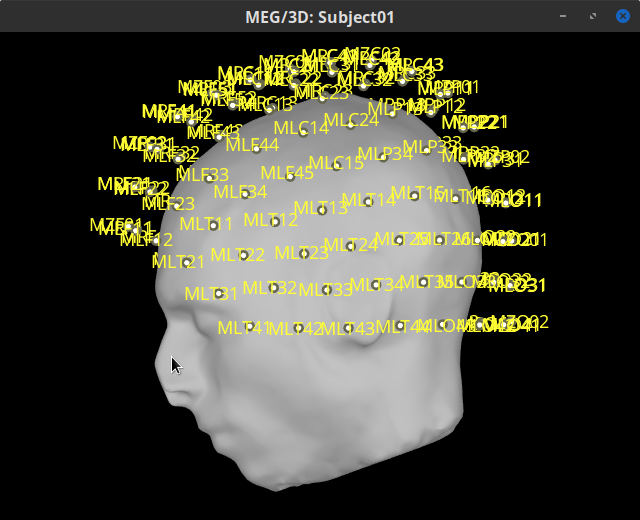
Reviewing continuous recordings
Right-click on the Link to raw file node, then Switch epoched/continuous to convert the file to continuous.
Right-click on the Link to raw file node, then MEG > Display time series (or double-click on the node). This will open a new time series figure and enable the Time panel and the Record tab in the main Brainstorm window. Controls in these two panels are used to explore the time series.
In addition we can display the EMG signals, right-click on the Link to raw file node, then EMG > Display time series.
Event markers
The colored dots on top of the recordings in the time series figures represent the event markers (or triggers) saved in this dataset. In addition to these events, the start of the either left or right trials is saved in the auxiliary channel named Stim. To add these markers:
With the time series figure open, in the Record tab go to File > Read events from channel. Now, in the options for the Read from channel process, set Event channels: to Stim, select Value, anc click Run.
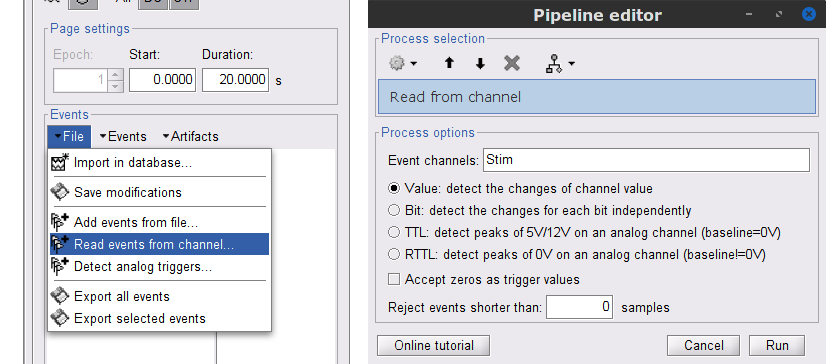
New events will appear, from these, we are only interested in the events from U1 to U25 that correspond to the 25 left trials. Thus we will remove the other events, and merge the left trial events.
Delete all the other events: select the events to delete with Ctrl+click, when done go the menu Events > Delete group and confirm. Alternatively, you can do Ctrl+A to select all the events and deselect the U1 to U25 events.
To be in line with the original FieldTrip tutorial, we will reject the trial 7. Select the events U1 to U6 and U8 to U25 events, then go the menu Events > Merge group and enter the label Left.
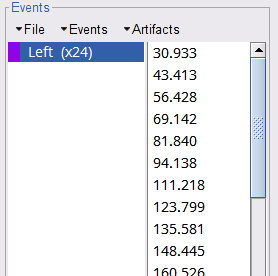
These events are located at the beginning of the 10 s trials of left wrist movement. In the following steps we will compute the coherence for 1 s epochs for the first 8 s of the trial, thus we need extra events.
Duplicate 7 times the Left events by selecting Duplicate group in the Events menu. This will create the groups Left_02 to Left_08.
To each copy of the Left events, we will add a time off, 1 s for Left02, 2 s for Left03, and so on. Select the event group to add the offset, then go to the menu Events > Delete group.
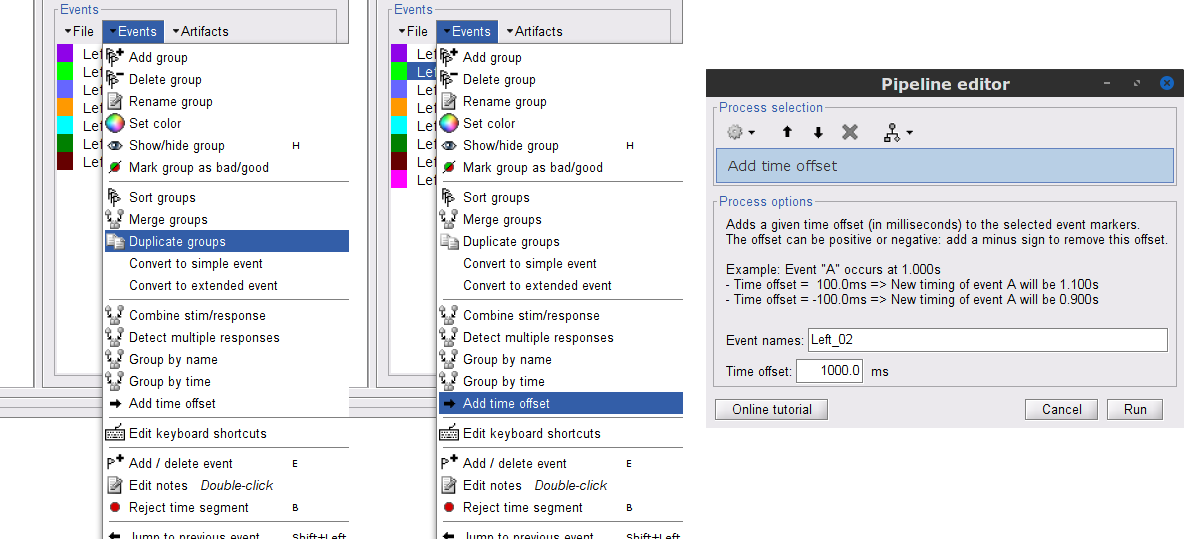
Finally merge all the Left events into Left, and select Save modifications in the File menu in the Record tab.
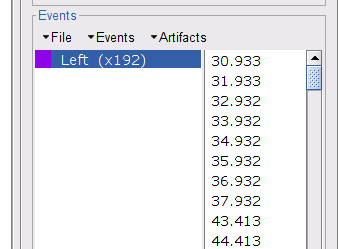
Pre-process MEG recordings
Three of the typical pre-processing steps for MEG recordings consist in:
removing the power line artifacts, 50 Hz for this recording
First, to avoid an excessive requirement of memory during the pre-processing, we need to create an intermediate file for the Link to raw file. This intermediate file will contain the same data as the original .ds file, but with the CTF compensation projector applied to the recordings values (instead of being just saved as linear operators on the side).
- In the Process1 box: Drag and drop the "Link to raw file".
Run process Artifacts > Apply SSP and CTF compensation
The intermediate file is located in named Raw | clean and is located in the the SubjectCMC_clean study.
FIGURE Process, and Tree
Power line artifacts
Let's start with locating the spectral components and impact of the power line noise.
- In the Process1 box: Drag and drop the "Link to raw file".
Run process Frequency > Power spectrum density (Welch)
All file, Window length=60 s and Overlap=50%.
Double-click on the new PSD file to display it.
The PSD shows relevant peaks at 50Hz, 150Hz and 250Hz. We will use notch filters to remove those frequency components from the MEG signals. Run the process Pre-processing > Notch filter with Frequencies to remove (Hz) = 50.00, 150.00, 250.00
- Compute the PSD for the filtered MEG signals to verify effect of the notch the filters.
Importing the recordings
Epoching
Source analysis
Coherence
Sensor level
Source level
Script
This should be label as advanced.
Additional documentation
Articles
Conway BA, Halliday DM, Farmer SF, Shahani U, Maas P, Weir AI, et al.
Synchronization between motor cortex and spinal motoneuronal pool during the performance of a maintained motor task in man.
The Journal of Physiology. 1995 Dec 15;489(3):917–24.Kilner JM, Baker SN, Salenius S, Hari R, Lemon RN.
Human Cortical Muscle Coherence Is Directly Related to Specific Motor Parameters.
J Neurosci. 2000 Dec 1;20(23):8838–45.Liu J, Sheng Y, Liu H.
https://doi.org/10.3389/fnhum.2019.00100Corticomuscular%20Coherence%20and%20Its%20Applications:%20A%20Review. Front Hum Neurosci. 2019 Mar 20;13:100.
Tutorials
Tutorial: Volume source estimation
Forum discussions
Forum: Minimum norm units (pA.m): http://neuroimage.usc.edu/forums/showthread.php?1246

